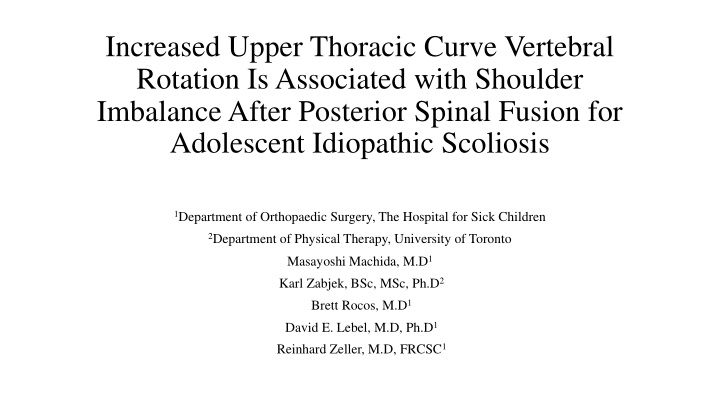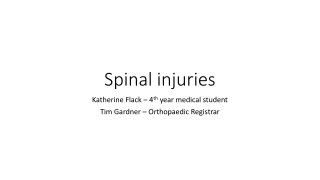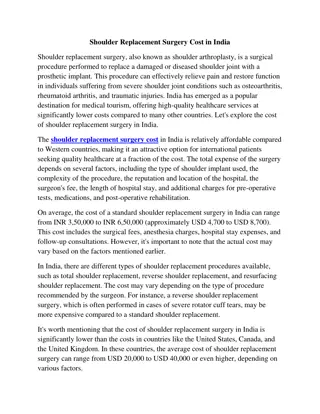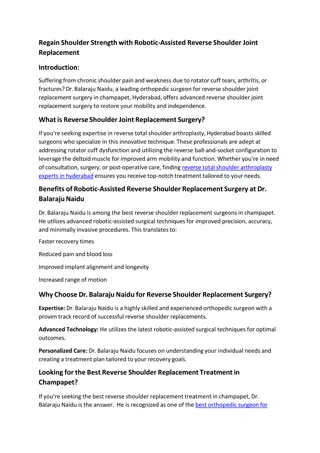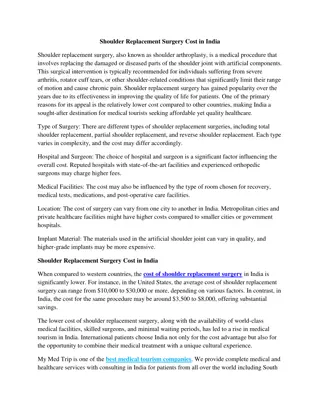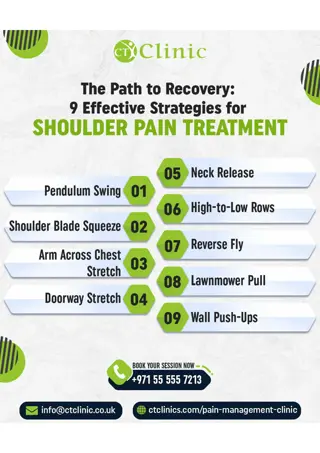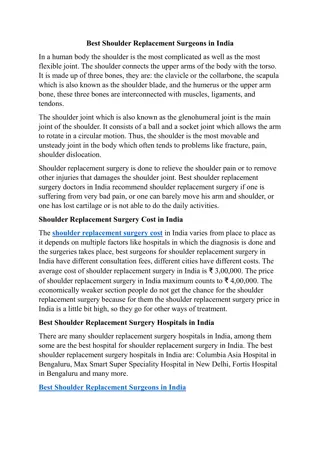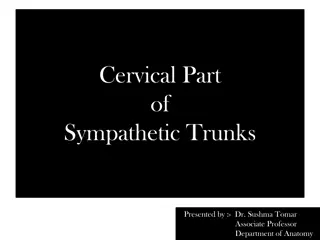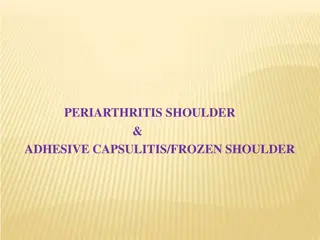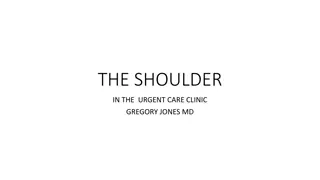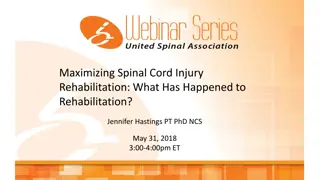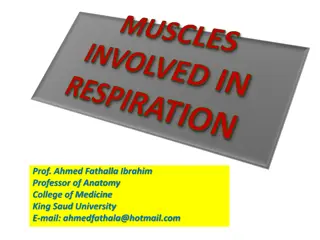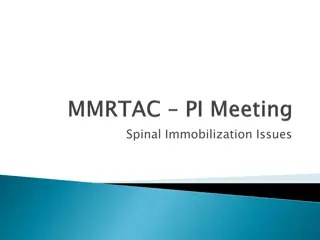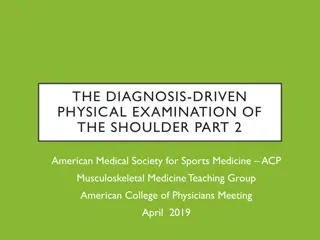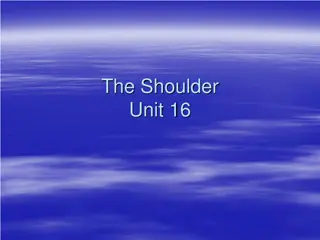Upper Thoracic Curve Rotation and Shoulder Imbalance Post-Spinal Fusion
This study explores the association between increased upper thoracic curve vertebral rotation and shoulder imbalance following posterior spinal fusion for adolescent idiopathic scoliosis. Radiographic measurements, demographics, and follow-up outcomes are analyzed to quantify the effect of surgery on shoulder balance and spinal alignment.
Download Presentation

Please find below an Image/Link to download the presentation.
The content on the website is provided AS IS for your information and personal use only. It may not be sold, licensed, or shared on other websites without obtaining consent from the author.If you encounter any issues during the download, it is possible that the publisher has removed the file from their server.
You are allowed to download the files provided on this website for personal or commercial use, subject to the condition that they are used lawfully. All files are the property of their respective owners.
The content on the website is provided AS IS for your information and personal use only. It may not be sold, licensed, or shared on other websites without obtaining consent from the author.
E N D
Presentation Transcript
Increased Upper Thoracic Curve Vertebral Rotation Is Associated with Shoulder Imbalance After Posterior Spinal Fusion for Adolescent Idiopathic Scoliosis 1Department of Orthopaedic Surgery, The Hospital for Sick Children 2Department of Physical Therapy, University of Toronto Masayoshi Machida, M.D1 Karl Zabjek, BSc, MSc, Ph.D2 Brett Rocos, M.D1 David E. Lebel, M.D, Ph.D1 Reinhard Zeller, M.D, FRCSC1
Background and Objective Scoliosis is a three-dimensional (3D) deformity consisting of coronal, sagittal, and axial rotation of the spinal column [1,2]. It has been increasingly recognized that the correction of apical vertebral rotation (AVR) and correcting shoulder balance are important indicators of successful correction [3-8]. Objective: 1. to quantify the effect of PSF on AVR and shoulder balance during and over 2 years follow up with sterEOS. 2. to determine the relationship between the global and local indices of spinal alignment with shoulder balance both pre and post-operatively.
Material and Method Study design: case series study Patients with AIS that underwent PSF in our institution between 2009 and 2017. Inclusion criteria Age < 18 years at the time of surgery Minimum 2-years of follow-up and sterEOS sterEOS images with reproducible shoulder assessment landmarks Exclusion criteria patients underwent revision or anterior surgery Radiographic measurements were taken at 1week postoperative and final follow-up. Statistic analysis: Pearson product-moment correlation
Result Table: the patients demographics Parameters Mean SD or n (%) N=66 14.8 1.5 Age (years) Sex Female Male 63 (95%) 3 (5%) Risser sign Risser 0 Risser 1 Risser 2 Risser 3 Risser 4 Risser 5 4 (6.1%) 4 (6.1%) 7 (10.6%) 7 (10.6%) 21 (31.8%) 23 (34.8%) 2.8 1.1 Final follow up (years) Type of curve Lenke type 1 Lenke type 2 Lenke type 3 Lenke type 4 Lenke type 5 Lenke type 6 SD: standard deviation 31 (47.0%) 10 (15.2%) 11 (16.7%) 3 (4.5%) 9 (13.6%) 2 (3.0%)
Result Table:Radiographical summary of patient cohort Preoperative Immediate postoperative 6 months postoperative Final follow PT Cobb angle ( ) 32 13 18 7.1 17 8.1 17 7.4 MT Cobb angle ( ) TK(T4/12) ( ) LL(L1/5) ( ) RSHD (mm) PT AVR ( ) MT AVR ( ) PT: proximal thoracic, MT: main thoracic TK: thoracic kyphosis, LL: lumber lordosis RSHD: radiographic shoulder height difference AVR: apical vertebral rotation Value: mean standard deviation 76 14 20 16 48 12 14 14 13 3.7 -14 13 21 7.3 17 9.4 43 8.8 -15 12 8.2 2.5 -6.8 7.3 21 7.4 18 9.2 45 7.4 -8.5 11 8.8 2.4 -7.7 7.0 22 7.4 20 8.5 49 7.7 -8.3 8.7 8.8 2.1 -6.8 6.9
Result Table: Correlation coefficient between RSHD at final follow-up and other radiographic parameters at each period RSHD at preoperative RSHD at immediate postoperative RSHD at 6 months postoperative RSHD at final follow up r=-0.22 p=0.075 r=-0.16 p=0.20 r=-0.12 p=0.32 r=-0.043 p=0.73 r=-0.11 p=0.36 r=0.18 p=0.14 r=-0.27* p=0.028 r=-0.0083 p=0.95 r=0.074 p=0.55 r=0.16 p=0.21 r=-0.26* p=0.037 r=0.10 p=0.41 r=-0.34* p=0.0048 r=-0.020 p=0.88 r=0.010 p=0.94 r=-0.15 p=0.22 r=-0.29* p=0.017 r=0.25* P=0.046 r=-0.37* p=0.0020 r=0.061 p=0.63 r=0.0035 p=0.98 r=0.096 p=0.44 r=-0.28* p=0.022 r=0.23 p=0.066 PT Cobb MT Cobb TK (T4/12) LL (L1/5) PT AVR MT AVR
Discussion Significant correlation between PT and MT AVR and RSHD 1. larger PT AVR associated with left shoulder elevation 2. the closer MT AVR is to zero the closer to level the shoulder balance AVR correlates postoperative shoulder balance and AVR correlates clinically with rib prominence. rib prominence pushes the scapula backwards and upwards with the shoulder sliding laterally and forward.
Conclusion A significant correlation between postoperative RSHD and PT and MT AVR for AIS was found. PT Cobb angle and PT and MT AVR associated with shoulder imbalance in AIS.
references Mehta MH (1973) Radiographic estimation of vertebral rotation in scoliosis. J Bone Joint Surg Br 55:513-520 1) Perdriolle R, Vidal J (1987) Morphology of scoliosis: three-dimensional evolution. Orthopedics 10:909-915 2) Kato S, Debaud C, Zeller RD (2017) Three-dimensional EOS analysis of apical vertebral rotation in adolescent idiopathic scoliosis.J Pediatr Orthop 37:543-547 3) Gotfryd AO, Silber Caffaro MF, Meves R et al (2017) Predictors for postoperative shoulder balance in Lenke 1 adolescent idiopathic scoliosis: a prospective cohort study. Spine Deform 5:66-71 4) Kuklo TR, Lenke LG, Graham EJ et al (2002) Correlation of radiographic, clinical, and patient assessment of shoulder balance following fusion versus non fusion of the proximal thoracic curve in adolescent idiopathic scoliosis. Spine 27:2013-2020 5) Asher MA, Burton DC (2006) Adolescent idiopathic scoliosis: natural history and long term treatment effects. Scoliosis 1:2 6) Carlson BB, Asher MA, Burton DC (2013) Comparison of trunk and spine deformity in adolescent idiopathic scoliosis. Scoliosis 8:2 7) Sanders AE, Baumann R, Brown H (2003) Selective anterior fusion of thoracolumbar/lumbar curves in adolescents: when can the associated thoracic curve be left unfused? Spine 28:706-713 8)
